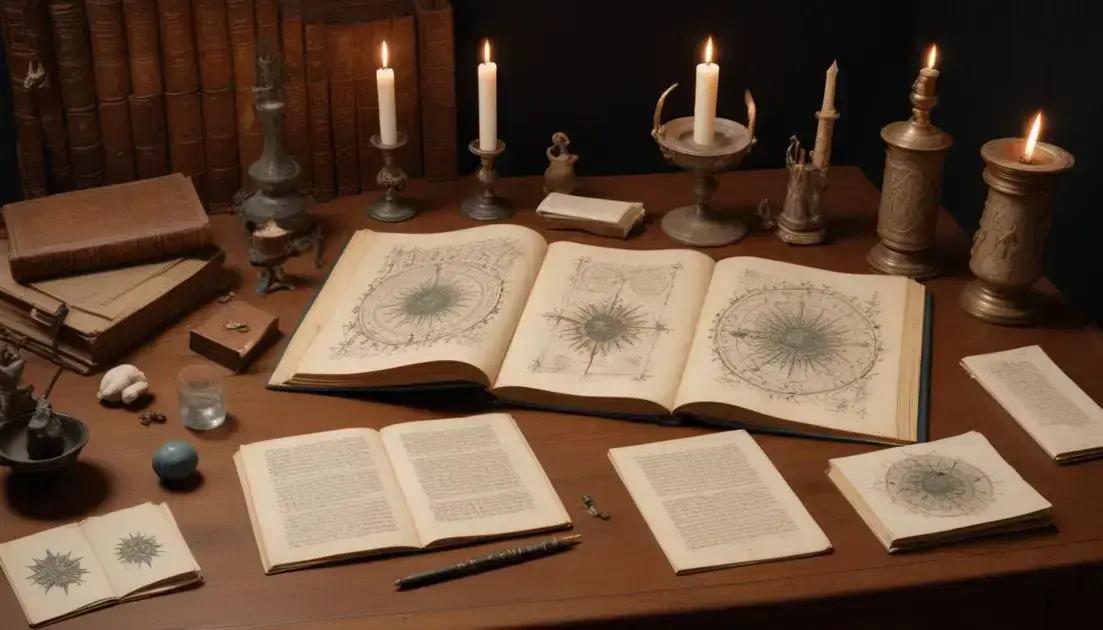
Voynich Manuscript: The World’s Most Mysterious Book
The Voynich Manuscript is a 15th-century text written in an unknown script that features peculiar illustrations, sparking endless curiosity and numerous theories about its purpose. Research into the manuscript employs modern technology like AI and pattern recognition to decipher its content, while its cultural impact inspires artists, writers, and scholars worldwide, keeping the mystery alive and encouraging exploration of its secrets.
The Voynich Manuscript is a fascinating enigma that has puzzled historians and cryptographers for centuries. Have you ever wondered why its secrets remain hidden?
The Origins of the Voynich Manuscript
The Voynich Manuscript is a mysterious book that dates back to the early 15th century. Its origins are still unclear, and many scholars have wondered who wrote it and why. The manuscript was named after Wilfrid Voynich, a rare book dealer who discovered it in 1912.
The text is written in an unknown script, and it contains various illustrations of plants, astrological symbols, and even naked figures. Some believe it was created in Italy, while others suggest it might have come from Central Europe.
One popular theory is that the manuscript was commissioned by a wealthy individual who wanted to preserve knowledge about herbal medicine, astrology, and other topics. The drawings and text could be a way to compile this information.
Another idea is that the manuscript was created as a prank or a hoax. Some believe it’s an elaborate joke, made to confuse scholars and historians. However, the truth is still a mystery.
Despite numerous attempts to decode the text, no one has succeeded, making the Voynich Manuscript an intriguing puzzle. Researchers have tried using different methods, but the strange language remains unsolved.
Attempts to Decipher the Text
Many people have tried to decode the Voynich Manuscript. These attempts started soon after it was discovered. Cryptographers, historians, and amateur codebreakers have all taken a shot at solving this mystery.
One key difficulty is the unique language used in the manuscript. It doesn’t match any known language, which makes it tough to crack. Some experts believe it might be a constructed language. This means it was made up instead of evolving naturally.
Many methods have been used to try to decipher the text. Some attempted to find patterns in the letters and words. Others used computer programs to analyze the writing style. Despite these efforts, no one has proven successful.
One noteworthy attempt came from William Friedman, a famous American cryptographer. He believed the manuscript could be a coded message. Despite his efforts, he could not uncover its secrets. This shows how complex the manuscript truly is.
People also tried to relate the illustrations in the book to the text. Some think the drawings might suggest what the text talks about. However, this idea hasn’t led to concrete answers.
Even modern technology hasn’t cracked the code. Researchers now use AI algorithms and statistical methods to search for clues. Still, the text remains a puzzling riddle waiting to be solved.
Unique Illustrations and Their Meanings
The Voynich Manuscript features many unique illustrations. These images make the book even more fascinating. From strange plants to unusual symbols, each illustration sparks curiosity.
One section shows various plants. Some look like real herbs, but others are completely imaginary. This mix raises questions about their purpose. Why include odd plants? Some experts think these illustrations might hold herbal knowledge.
Another part of the manuscript contains astrological diagrams. These images show the positions of stars and planets. They suggest the manuscript might have a connection to astrology. Scholars believe this could indicate its purpose in old medicinal practices.
One especially curious illustration is of naked figures in elaborate settings. These images could represent fertility or nature’s cycles. Their meaning is still up for debate, adding to the mystery of the book.
Interestingly, no one fully understands all the illustrations. Each image could point to lost knowledge or hidden meanings. This leaves room for interpretation and invites viewers to think creatively.
As researchers study these images, each new idea brings fresh insights. The artwork not only captivates but also offers clues about the manuscript’s purpose. However, like the text, many secrets remain hidden within these illustrations.
Theories About Its Purpose
The purpose of the Voynich Manuscript is still a big mystery. Many theories try to explain why this strange book was created. Each idea brings new excitement and intrigue.
One popular theory suggests that it was a herbal medicine guide. People think the illustrations of plants might show how to use them for healing. This idea makes sense given the manuscript’s detailed drawings.
Another theory claims it could be an astrological text. Some illustrations show zodiac signs and celestial bodies. This leads some researchers to believe it served to guide people in their daily lives based on astrological knowledge.
Some think it was simply made as a hoax or an elaborate prank. They argue that the author wanted to confuse scholars and historians. If that’s true, the maker certainly succeeded!
There’s also a theory that suggests it was a secret language. Some people believe it was created to hide messages. This idea points to a time when sharing certain knowledge needed to be kept safe.
Each theory highlights the many different ways to view this unique manuscript. Theories spark debate, leading many to study it further. The true purpose of the Voynich Manuscript remains unknown, but that’s part of its allure.
Modern Technology and the Manuscript
Modern technology plays a big role in studying the Voynich Manuscript. Researchers use new methods to uncover its secrets. This includes advanced tools like computer algorithms and artificial intelligence.
One exciting use of technology is pattern recognition software. This software analyzes the text to find patterns and repetitions. By doing this, scientists hope to discover hints about the manuscript’s language.
Moreover, AI is helping researchers make comparisons with other texts. It can quickly check thousands of documents. This saves time and can lead to new insights about the manuscript.
3D imaging is another tool used to examine the manuscript. It reveals details that are hard to see with the naked eye. This technology can show tiny features of the illustrations and text.
Some experts also use machine learning to study the artwork. This approach helps identify similarities with plants and symbols in other cultures. Finding these connections can deepen our understanding of the manuscript’s purpose.
While these technologies offer great promise, challenges remain. The complex nature of the manuscript means there’s still no clear answer. However, the blend of modern tech and old mysteries makes this research exciting.
Cultural Impact of the Voynich Manuscript
The Voynich Manuscript has made a significant cultural impact over the years. Its mystery captures the imagination of many. This unique book draws interest from all corners of the world, from scientists to artists.
Its strange text and illustrations have inspired countless theories and stories. Many writers have included it in novels and films, showcasing its reputation as a mysterious artifact. Some view it as a symbol of our quest for knowledge.
Artists are also inspired by the manuscript. The bizarre plants and astrological diagrams give rise to new creative works. The manuscript encourages new interpretations and artistic expressions, making it a source of endless creativity.
The Voynich Manuscript is often a hot topic at conferences and lectures. Scholars discuss its origins and meanings, sparking debates about cryptography and history. This ongoing dialogue helps deepen our understanding of historical texts.
Furthermore, this enigmatic book connects people. Enthusiasts form communities online to share ideas and theories. They support each other in the journey to unlock its secrets.
The manuscript’s influence extends beyond academics. It invites us to think critically and remain curious about the unknown. Ultimately, the Voynich Manuscript serves as a reminder of the mysteries that still exist in our world.
Conclusion
In conclusion, the Voynich Manuscript continues to captivate our imagination. Its mysterious text and unique illustrations spark curiosity and debate. Many scholars and enthusiasts dedicate their time to uncovering its secrets.
Modern technology plays a crucial role in exploring the manuscript. Tools like AI and pattern recognition help researchers dive deeper into its meaning. These advancements open new doors in understanding the past.
The cultural impact of the manuscript is also significant. It inspires artists, writers, and thinkers around the world. Through its secrets, the Voynich Manuscript connects people and encourages creative expression.
As long as the manuscript remains unsolved, it will keep pushing us to explore the unknown. The journey to understand this enigmatic book is as enriching as the discoveries we make along the way.


